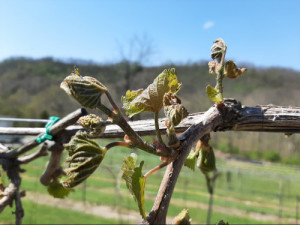Frost Grips Grapes in Southern Ohio

Frost damaged early blooming grape varieties last week in southern Ohio. OSU Extension photo.

Frost Grips Grapes in Southern Ohio
By Alayna DeMartini
COLUMBUS, Ohio—Southern Ohio vineyards took a hit last week when frost killed off early emerging buds, and northern Ohio grape growers are bracing for the potential in their area as well.
“Some grape varieties like Chardonnay got absolutely obliterated in southern Ohio,” said Maria Smith, viticulture outreach specialist at the Department of Horticulture and Crop Science within The Ohio State University College of Food, Agricultural, and Environmental Sciences (CFAES).
“For grape growers and some wineries, it’s a very big deal. You have vineyards that can’t cover the cost of the season because they lost one or two varieties of grapes.”
While spring frosts can threaten vineyards across the state, the prospects for Ohio’s grapes this year still are good. Northern Ohio vineyards, which were unscathed by last week’s frost, generate about 80% of the state’s grapes; southern and central Ohio, 20%.
Mild winters, such as the one we had this year, encourage the early emergence of some grape buds. In southern Ohio, which is typically warmer than northern Ohio, grapes were further ahead in their growth, so their buds were vulnerable to the frost that occurred between April 15 and April 17.
“We had such a nice winter that we thought, ‘This is great.’ But because it was so mild, I’d been thinking this might happen,” Smith said.
It doesn’t have to be very cold for very long for grape buds to be damaged. The lowest temperature the shoots can survive is 28 degrees Fahrenheit, and last week, temperatures dipped below 28 degrees in parts of southern Ohio, Smith said. As a result, early emerging grape varieties, including Chardonnay, Niagara, and Marquette, all suffered damage.
Still, all hope is not lost. Secondary buds might still emerge from those vines, but they typically generate fewer grapes—40% to 70% fewer than the initial buds, Smith said.
For now, vineyard owners in southern Ohio can only cross their fingers and hope that secondary buds grow.
“There’s nothing you can spray. There’s nothing you can do to change the outcome of what has happened,” Smith said. “The best thing to do is wait and evaluate the amount of injury.”
Meanwhile, grape growers in northeast Ohio, which produces the bulk of the state’s crop, can take precautions by delaying pruning of their vines. That will slow the growth of buds until the threat of frost is over, typically by May 15, said Imed Dami, a CFAES viticulture professor and state specialist.
Mowing the grass or cover crop grown between the rows of vines will allow the soil to retain more heat to keep the vines warm in case there’s a frost. Another alternative is to spray a copper compound as soon as young grape shoots emerge and then every five to seven days until the vineyard is out of the frost threat period. Gas-powered fans, though expensive, can also be effective during a frost.
“I want our growers to be ready,” Dami said. “In our experience, you never really know.”
For more information on frost prevention in vineyards, including tips, visit: go.osu.edu/frostaid.






